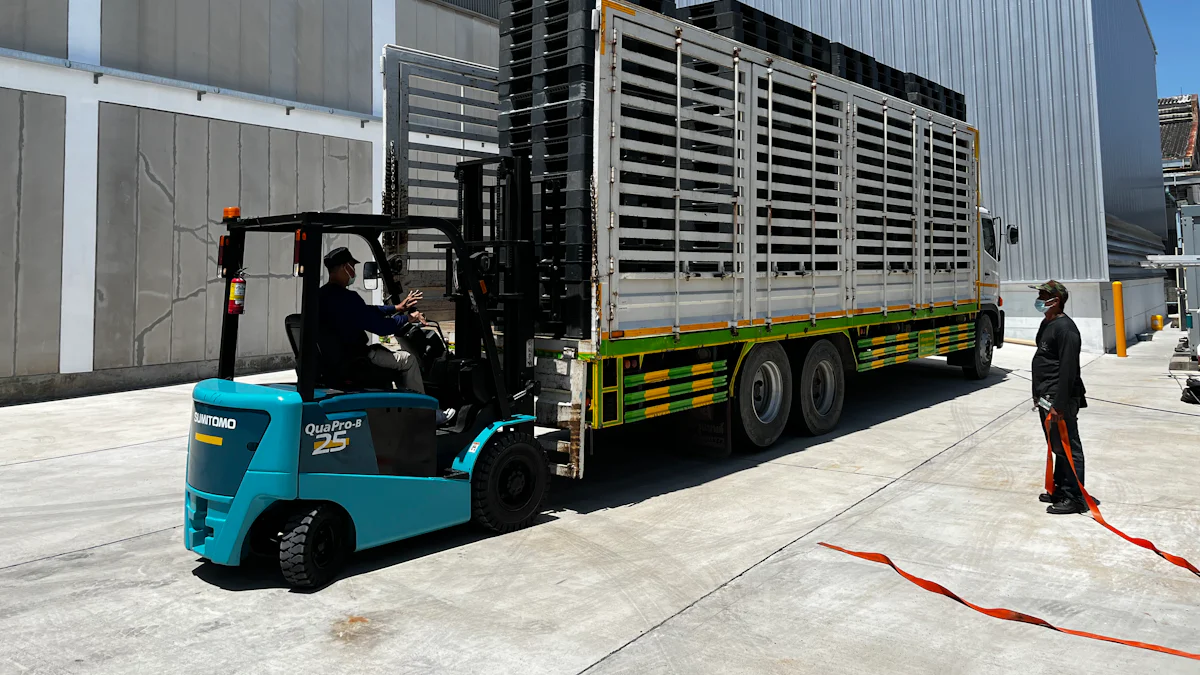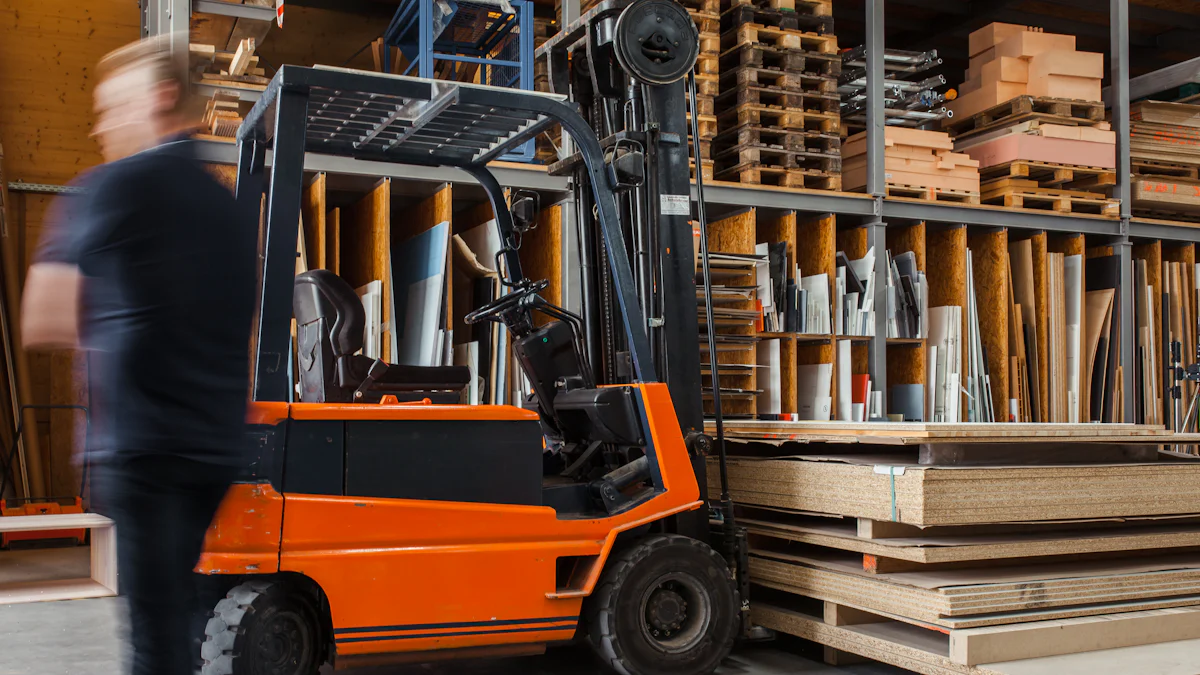
Understanding pallet truck sizes is crucial for efficient material handling operations. This comprehensive guide delves into the significance of selecting the right pallet jack dimensions to optimize workflow and productivity. The blog will explore various standard and specialized sizes, shedding light on their applications and benefits across different industries.
Understanding Pallet Truck Sizes
When considering pallet truck sizes, it is essential to grasp the significance of selecting the appropriate dimensions for efficient material handling operations. The size of a pallet jack directly impacts workflow and productivity in various industries, making it a critical aspect of operational success.
Definition and Importance
What is a Pallet Truck?
A pallet truck, also known as a pallet jack, is a manual or powered tool used to lift and move pallets within a warehouse or storage facility. It consists of forks that slide under pallets, allowing operators to raise and transport heavy loads with ease.
Why Size Matters
The size of a pallet truck plays a crucial role in its functionality. Choosing the right dimensions ensures compatibility with standard pallet sizes, enhances maneuverability, and optimizes space utilization within different work environments.
Common Applications
Warehouses
In warehouses, pallet trucks are indispensable tools for transporting goods between storage areas and delivery zones. Their versatility and ease of use make them ideal for efficiently moving heavy loads over short distances.
Distribution Centers
Distribution centers rely on pallet jacks to streamline the movement of products from incoming shipments to outgoing orders. By selecting the appropriate size based on load requirements, these facilities can maintain smooth operations throughout their logistics processes.
Retail Stockrooms
Retail stockrooms benefit greatly from the compact design and maneuverability of pallet trucks. These tools enable store employees to handle inventory efficiently, restock shelves promptly, and fulfill customer orders with precision.
Factors Influencing Size Selection
Load Capacity
The load capacity of a pallet truck determines its ability to handle different weights safely. By matching the truck’s capacity to the heaviest loads expected in daily operations, businesses can prevent accidents and ensure workplace safety.
Pallet Dimensions
Considering the standard sizes of pallets used in specific industries is crucial when selecting a pallet truck. Compatibility with common pallet dimensions such as 48 inches long by 40 inches wide ensures seamless integration into existing supply chain processes.
Operational Environment
The operational environment, including aisle widths, floor surfaces, and storage configurations, influences the choice of pallet truck size. Narrow aisles may require specialized narrow-width trucks for optimal maneuvering, while rough surfaces might necessitate models with enhanced stability features.
By understanding these key aspects related to pallet truck sizes, businesses can make informed decisions that align with their operational needs and enhance overall efficiency in material handling tasks.
Standard Pallet Truck Sizes

When considering pallet truck sizes, it is essential to delve into the realm of standard dimensions that cater to a wide range of material handling needs. Understanding the most common sizes, fork lengths, widths, load capacities, and raised and lowered heights provides businesses with valuable insights for selecting the optimal pallet jack for their operations.
Most Common Sizes
- The 27” x 48” pallet truck size stands out as a popular choice in various industries due to its versatility and compatibility with standard pallet dimensions.
- Alternatively, the 40” x 48” pallet truck size offers a broader cargo area, accommodating larger loads with ease while maintaining stability during transport.
Fork Lengths and Widths
- Standard fork lengths play a pivotal role in determining the type of loads a pallet truck can handle efficiently. Longer forks provide stability for larger items, while shorter forks are ideal for compact spaces.
- Similarly, standard fork widths influence the overall balance and maneuverability of a pallet jack. Wider forks offer increased support for wider loads, ensuring safe transportation within diverse operational settings.
Capacity and Dimensions
- Load capacities are crucial considerations when selecting a pallet truck size. Most standard pallet trucks have weight capacities ranging from 1500kg to 2000kg, catering to everyday material handling requirements effectively.
- For heavier loads up to 3000kg, businesses can opt for heavy-duty pallet trucks designed to withstand greater weight pressures without compromising performance.
- Raised and lowered heights of pallet trucks determine their adaptability to different shelving heights and loading docks. Understanding these dimensions enables operators to navigate varying elevation levels seamlessly.
By familiarizing themselves with the nuances of standard pallet truck sizes, businesses can make informed decisions that align with their specific material handling demands. Whether opting for common sizes or exploring specialized dimensions based on unique requirements, choosing the right pallet jack size is paramount for enhancing operational efficiency and productivity.
Specialized Pallet Truck Sizes
Narrow Pallet Jacks
When it comes to narrow pallet jacks, businesses can benefit from their versatile applications and ergonomic design. These specialized pallet trucks are specifically crafted to navigate tight spaces with ease, making them ideal for warehouses and storage facilities with limited aisle widths. The compact nature of narrow pallet jacks allows operators to maneuver efficiently in congested areas, enhancing overall productivity.
Narrow pallet jacks offer a range of benefits, including improved maneuverability, enhanced precision during load handling, and increased operational efficiency. By investing in these specialized pallet trucks, businesses can optimize their material handling processes and streamline workflow in confined spaces.
Double and Triple Pallet Jacks
For operations that involve handling multiple loads simultaneously, double and triple pallet jacks are indispensable tools. These specialized pallet trucks feature dual or triple sets of forks that enable operators to transport more than one pallet at a time, significantly increasing efficiency in high-volume environments.
The ability to handle multiple loads with double and triple pallet jacks reduces the number of trips required to move goods, saving time and labor costs. By maximizing load capacity per trip, businesses can expedite order fulfillment processes and improve overall warehouse throughput.
Extended Length Pallet Trucks
Extended length pallet trucks, equipped with fork lengths of 60 inches or above, cater to the unique needs of industries dealing with oversized or elongated loads. These specialized pallet trucks provide stability and support for longer items, such as lumber, pipes, or large containers, ensuring safe transportation within industrial settings.
By utilizing extended length pallet trucks, businesses can efficiently handle non-standard cargo while maintaining operational safety standards. The extended forks offer increased surface area contact with loads, reducing the risk of slippage or instability during transport.
Incorporating specialized pallet truck sizes like narrow jacks, double/triple jacks, and extended length trucks into material handling operations can revolutionize workflow efficiency and enhance productivity across various industries.
Choosing the Right Pallet Truck

Assessing Your Needs
To ensure optimal material handling efficiency, businesses must carefully evaluate their requirements when selecting a pallet jack. By assessing load specifications and space limitations, organizations can make informed decisions that align with their operational demands.
Load Requirements
Determining the weight capacities necessary for daily operations is a critical step in choosing the right pallet truck. By analyzing the heaviest loads typically handled within the facility, businesses can select a pallet jack with sufficient capacity to transport goods safely and efficiently.
- Identify the maximum weight thresholds for palletized items
- Consider future growth projections to accommodate potential increases in load sizes
- Evaluate the distribution of heavy loads across different operational areas
Space Constraints
Understanding spatial limitations within warehouses or storage facilities is essential for selecting an appropriately sized pallet truck. By considering aisle widths, storage heights, and maneuvering spaces, businesses can choose a pallet jack that navigates smoothly through confined areas without compromising safety or productivity.
- Measure aisle widths to determine compatibility with standard pallet truck dimensions
- Assess vertical clearances for loading docks and shelving systems
- Account for turning radii to ensure seamless movement in tight corners
Making an Informed Decision
When investing in pallet trucks, organizations benefit from consulting industry experts and anticipating future operational needs. By seeking professional advice and planning for long-term requirements, businesses can optimize material handling processes and enhance overall workflow efficiency.
Consulting with Experts
Engaging with knowledgeable professionals in the material handling industry provides valuable insights into selecting the most suitable pallet truck for specific operational environments. Expert recommendations on size considerations, ergonomic features, and maintenance requirements empower businesses to make well-informed decisions that align with their unique needs.
“Expert consultations offer tailored solutions to enhance material handling operations effectively.”
- Collaborate with equipment suppliers to explore customized pallet jack options
- Seek guidance on optimizing workflow layouts for improved efficiency
- Implement best practices recommended by industry specialists
Considering Future Needs
Anticipating evolving business requirements is crucial when choosing a pallet truck size that supports long-term growth and adaptability. By evaluating scalability factors and potential changes in material handling volumes, organizations can invest in equipment that remains efficient and effective as operations expand.
- Plan for increased load capacities based on projected business growth
- Evaluate technological advancements in pallet jack design for enhanced performance
- Incorporate flexibility features to accommodate changing operational demands
By prioritizing thorough assessments of load specifications, space constraints, expert consultations, and future considerations, businesses can confidently select the right pallet truck size to optimize material handling operations effectively.
Selecting the appropriate pallet jack size is paramount for maximizing productivity, streamlining operations, and ensuring workforce safety. By choosing the right pallet truck tailored to specific needs, businesses can optimize material handling processes, enhance overall efficiency, and boost profitability. A well-suited pallet jack empowers teams to handle heavy loads with ease, streamline warehouse operations, and increase productivity significantly. Investing in the correct pallet truck directly impacts the efficiency and safety of material handling operations, making a substantial difference in business performance and employee well-being.
Post time: Jun-06-2024
